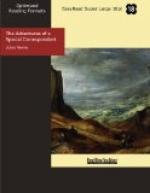Here was the unexpected, indeed; the uncertainty of a special correspondent’s life.
At this time the Russian railways had been connected with the line between Poti, Tiflis and Baku. After a long and increasing run through the Southern Russian provinces I had crossed the Caucasus, and imagined I was to have a little rest in the capital of Transcaucasia. And here was the imperious administration of the Twentieth Century giving me only half a day’s halt in this town! I had hardly arrived before I was obliged to be off again without unstrapping my portmanteau! But what would you have? We must bow to the exigencies of special correspondence and the modern interview!
But all the same I had been carefully studying this Transcaucasian district, and was well provided with geographic and ethnologic memoranda. Perhaps it may be as well for you to know that the fur cap, in the shape of a turban, which forms the headgear of the mountaineers and cossacks is called a “papakha,” that the overcoat gathered in at the waist, over which the cartridge belt is hung, is called a “tcherkeska” by some and “bechmet” by others! Be prepared to assert that the Georgians and Armenians wear a sugar-loaf hat, that the merchants wear a “touloupa,” a sort of sheepskin cape, that the Kurd and Parsee still wear the “bourka,” a cloak in a material something like plush which is always waterproofed.
And of the headgear of the Georgian ladies, the “tassakravi,” composed of a light ribbon, a woolen veil, or piece of muslin round such lovely faces; and their gowns of startling colors, with the wide open sleeves, their under skirts fitted to the figure, their winter cloak of velvet, trimmed with fur and silver gimp, their summer mantle of white cotton, the “tchadre,” which they tie tight on the neck—all those fashions in fact so carefully entered in my notebook, what shall I say of them?
Learn, then, that their national orchestras are composed of “zournas,” which are shrill flutes; “salamouris,” which are squeaky clarinets; mandolines, with copper strings, twanged with a feather; “tchianouris,” violins, which are played upright; “dimplipitos,” a kind of cymbals which rattle like hail on a window pane.
Know that the “schaska” is a sword hung from a bandolier trimmed with studs and silver embroidery, that the “kindjall” or “kandijar” is a dagger worn in the belt, that the armament of the soldiers of the Caucasus is completed by a long Damascus gun ornamented with bands of chiseled metal.
Know that the “tarantass” is a sort of berline hung on five pieces of rather elastic wood between wheels placed rather wide apart and of moderate height; that this carriage is driven by a “yemtchik,” on the front seat, who has three horses, to whom is added a postilion, the “faletre,” when it is necessary to hire a fourth horse from the “smatritel,” who is the postmaster on the Caucasian roads.
Know, then, that the verst is two-thirds of a mile, that the different nomadic people of the governments of Transcaucasia are composed of Kalmucks, descendants of the Eleuthes, fifteen thousand, Kirghizes of Mussulman origin eight thousand, Koundrof Tartars eleven hundred, Sartof Tartars a hundred and twelve, Nogais eight thousand five hundred, Turkomans nearly four thousand.




